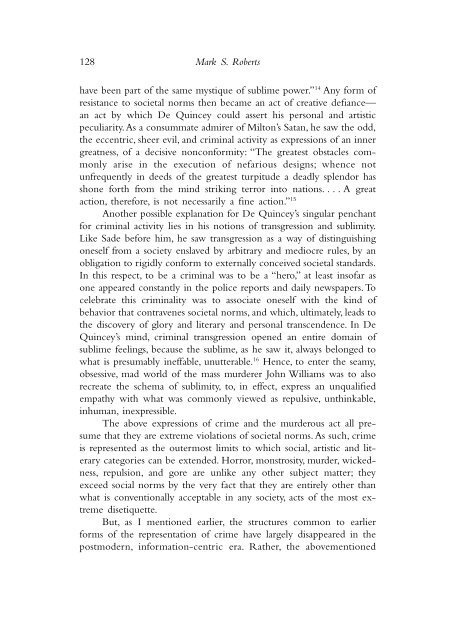Create successful ePaper yourself
Turn your PDF publications into a flip-book with our unique Google optimized e-Paper software.
128 Mark S. Roberts<br />
have been part <strong>of</strong> <strong>the</strong> same mystique <strong>of</strong> sublime power.” 14 Any form <strong>of</strong><br />
resistance to societal norms <strong>the</strong>n became an act <strong>of</strong> creative defiance—<br />
an act by which De Quincey could assert his personal and artistic<br />
peculiarity. As a consummate admirer <strong>of</strong> Milton’s Satan, he saw <strong>the</strong> odd,<br />
<strong>the</strong> eccentric, sheer evil, and criminal activity as expressions <strong>of</strong> an inner<br />
greatness, <strong>of</strong> a decisive nonconformity: “The greatest obstacles commonly<br />
arise in <strong>the</strong> execution <strong>of</strong> nefarious designs; whence not<br />
unfrequently in deeds <strong>of</strong> <strong>the</strong> greatest turpitude a deadly splendor has<br />
shone forth from <strong>the</strong> mind striking terror into nations. . . . A great<br />
action, <strong>the</strong>refore, is not necessarily a fine action.” 15<br />
Ano<strong>the</strong>r possible explanation for De Quincey’s singular penchant<br />
for criminal activity lies in his notions <strong>of</strong> transgression and sublimity.<br />
Like Sade before him, he saw transgression as a way <strong>of</strong> distinguishing<br />
oneself from a society enslaved by arbitrary and mediocre rules, by an<br />
obligation to rigidly conform to externally conceived societal standards.<br />
In this respect, to be a criminal was to be a “hero,” at least ins<strong>of</strong>ar as<br />
one appeared constantly in <strong>the</strong> police reports and daily newspapers. To<br />
celebrate this criminality was to associate oneself with <strong>the</strong> kind <strong>of</strong><br />
behavior that contravenes societal norms, and which, ultimately, leads to<br />
<strong>the</strong> discovery <strong>of</strong> glory and literary and personal transcendence. In De<br />
Quincey’s mind, criminal transgression opened an entire domain <strong>of</strong><br />
sublime feelings, because <strong>the</strong> sublime, as he saw it, always belonged to<br />
what is presumably ineffable, unutterable. 16 Hence, to enter <strong>the</strong> seamy,<br />
obsessive, mad world <strong>of</strong> <strong>the</strong> mass murderer John Williams was to also<br />
recreate <strong>the</strong> schema <strong>of</strong> sublimity, to, in effect, express an unqualified<br />
empathy with what was commonly viewed as repulsive, unthinkable,<br />
inhuman, inexpressible.<br />
The above expressions <strong>of</strong> crime and <strong>the</strong> murderous act all presume<br />
that <strong>the</strong>y are extreme violations <strong>of</strong> societal norms. As such, crime<br />
is represented as <strong>the</strong> outermost limits to which social, artistic and literary<br />
categories can be extended. Horror, monstrosity, murder, wickedness,<br />
repulsion, and gore are unlike any o<strong>the</strong>r subject matter; <strong>the</strong>y<br />
exceed social norms by <strong>the</strong> very fact that <strong>the</strong>y are entirely o<strong>the</strong>r than<br />
what is conventionally acceptable in any society, acts <strong>of</strong> <strong>the</strong> most extreme<br />
disetiquette.<br />
But, as I mentioned earlier, <strong>the</strong> structures common to earlier<br />
forms <strong>of</strong> <strong>the</strong> representation <strong>of</strong> crime have largely disappeared in <strong>the</strong><br />
postmodern, information-centric era. Ra<strong>the</strong>r, <strong>the</strong> abovementioned
















